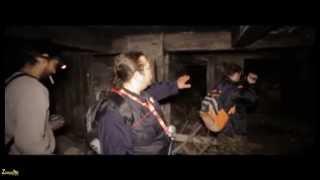_powered by_
L O F E ™
How to Fall While Rock Climbing
When you progress from top-rope climbing to lead climbing, falls can drop you farther—up to twice as far as you’ve ascended above your last clip-in point. By learning how to fall, you help minimize your risk of injury.
Because falling is a natural byproduct of pushing yourself and learning new skills, managing the fear of falling is also key to progressing as a lead climber. By gaining a level of comfort with the experience, you free yourself to focus on the development of your skills rather than your primal fears.
Gear considerations: Because falling is always a possibility, no special gear is needed beyond your lead climbing gear. It’s worth another look at your helmet, though, because a helmet that's dented, cracked or more than 10 years old needs to be replaced. Learn more about helmet choice in our Expert Advice article, Helmet: How to Choose.
Becoming more comfortable with falling breaks down into three phases:
1 Knowing where to be in relation to the rope.
2 Clearly communicating with your belayer.
3 Achieving a clean flight path.
Keep an Eye on Your Rope
Tangling with your rope when you come off the wall leads to bad outcomes, especially if your leg catches and you flip upside down.
⚫ Always keep the rope between you and the wall.
⚫ If the rope runs off to one side, be sure it’s closer to the wall than you are.
⚫ If the rope has gotten behind any part of your leg, step out and over the rope again.
Strive for a Clean Flight Path
You can’t control everything when the moment arrives, but concentrating on a few keys makes a huge difference. If you have a straight drop from an overhang, relax, exhale and try not to tense up because that makes the jolt more severe when you bottom out.
For most falls, follow these steps:
⚫ Look down for any obstructions in your path.
⚫ Don’t push off unless it’s to clear an obstruction—pushing off leads to a harder smack when the rope swings you, pendulum-style, back to the wall.
⚫ Do keep your arms at chest level with elbows and knees bent slightly.
⚫ Breathe out when you’re airborne because it reflexively makes you relax.
⚫ Don’t grab anything on the way down—you risk severe finger trauma.
⚫ Try for a soft landing with your feet, keeping your hands ready.
Mental Preparation
Often the mind gives in before you physically lose your grip. So strive for a healthy mindset before and during the climb:
⚫ Make a plan before the climb: Decide your tactics for the crux and identify places where you can rest.
⚫ Do your safety checks: You'll reduce risk and boost confidence.
⚫ Trust your belayer.
⚫ Breathe throughout the climb: You'll boost both physical and mental acuity.
▉Remember▉ Safety is your responsibility. No article or video can replace proper instruction and experience—this article is intended solely as supplemental information. Be sure you practice proper techniques and safety guidelines before you climb.
—————————————————————————————————————
We do NOT own the video materials and all credits belong to respectful owners or to the “public domain,” making them free for everyone to use. In case of copyright issues, please contact us immediately for further credits or clip delete.
FAIR USE NOTICE: This video may contain copyrighted material. This constitutes a 'fair use' of any such copyrighted material as provided for in Title 17 U.S.C. section 106A-117 of the U.S. Copyright Law. ⒻⓊ
L O F E ™
How to Fall While Rock Climbing
When you progress from top-rope climbing to lead climbing, falls can drop you farther—up to twice as far as you’ve ascended above your last clip-in point. By learning how to fall, you help minimize your risk of injury.
Because falling is a natural byproduct of pushing yourself and learning new skills, managing the fear of falling is also key to progressing as a lead climber. By gaining a level of comfort with the experience, you free yourself to focus on the development of your skills rather than your primal fears.
Gear considerations: Because falling is always a possibility, no special gear is needed beyond your lead climbing gear. It’s worth another look at your helmet, though, because a helmet that's dented, cracked or more than 10 years old needs to be replaced. Learn more about helmet choice in our Expert Advice article, Helmet: How to Choose.
Becoming more comfortable with falling breaks down into three phases:
1 Knowing where to be in relation to the rope.
2 Clearly communicating with your belayer.
3 Achieving a clean flight path.
Keep an Eye on Your Rope
Tangling with your rope when you come off the wall leads to bad outcomes, especially if your leg catches and you flip upside down.
⚫ Always keep the rope between you and the wall.
⚫ If the rope runs off to one side, be sure it’s closer to the wall than you are.
⚫ If the rope has gotten behind any part of your leg, step out and over the rope again.
Strive for a Clean Flight Path
You can’t control everything when the moment arrives, but concentrating on a few keys makes a huge difference. If you have a straight drop from an overhang, relax, exhale and try not to tense up because that makes the jolt more severe when you bottom out.
For most falls, follow these steps:
⚫ Look down for any obstructions in your path.
⚫ Don’t push off unless it’s to clear an obstruction—pushing off leads to a harder smack when the rope swings you, pendulum-style, back to the wall.
⚫ Do keep your arms at chest level with elbows and knees bent slightly.
⚫ Breathe out when you’re airborne because it reflexively makes you relax.
⚫ Don’t grab anything on the way down—you risk severe finger trauma.
⚫ Try for a soft landing with your feet, keeping your hands ready.
Mental Preparation
Often the mind gives in before you physically lose your grip. So strive for a healthy mindset before and during the climb:
⚫ Make a plan before the climb: Decide your tactics for the crux and identify places where you can rest.
⚫ Do your safety checks: You'll reduce risk and boost confidence.
⚫ Trust your belayer.
⚫ Breathe throughout the climb: You'll boost both physical and mental acuity.
▉Remember▉ Safety is your responsibility. No article or video can replace proper instruction and experience—this article is intended solely as supplemental information. Be sure you practice proper techniques and safety guidelines before you climb.
—————————————————————————————————————
We do NOT own the video materials and all credits belong to respectful owners or to the “public domain,” making them free for everyone to use. In case of copyright issues, please contact us immediately for further credits or clip delete.
FAIR USE NOTICE: This video may contain copyrighted material. This constitutes a 'fair use' of any such copyrighted material as provided for in Title 17 U.S.C. section 106A-117 of the U.S. Copyright Law. ⒻⓊ
Sign in or sign up to post comments.
Be the first to comment























